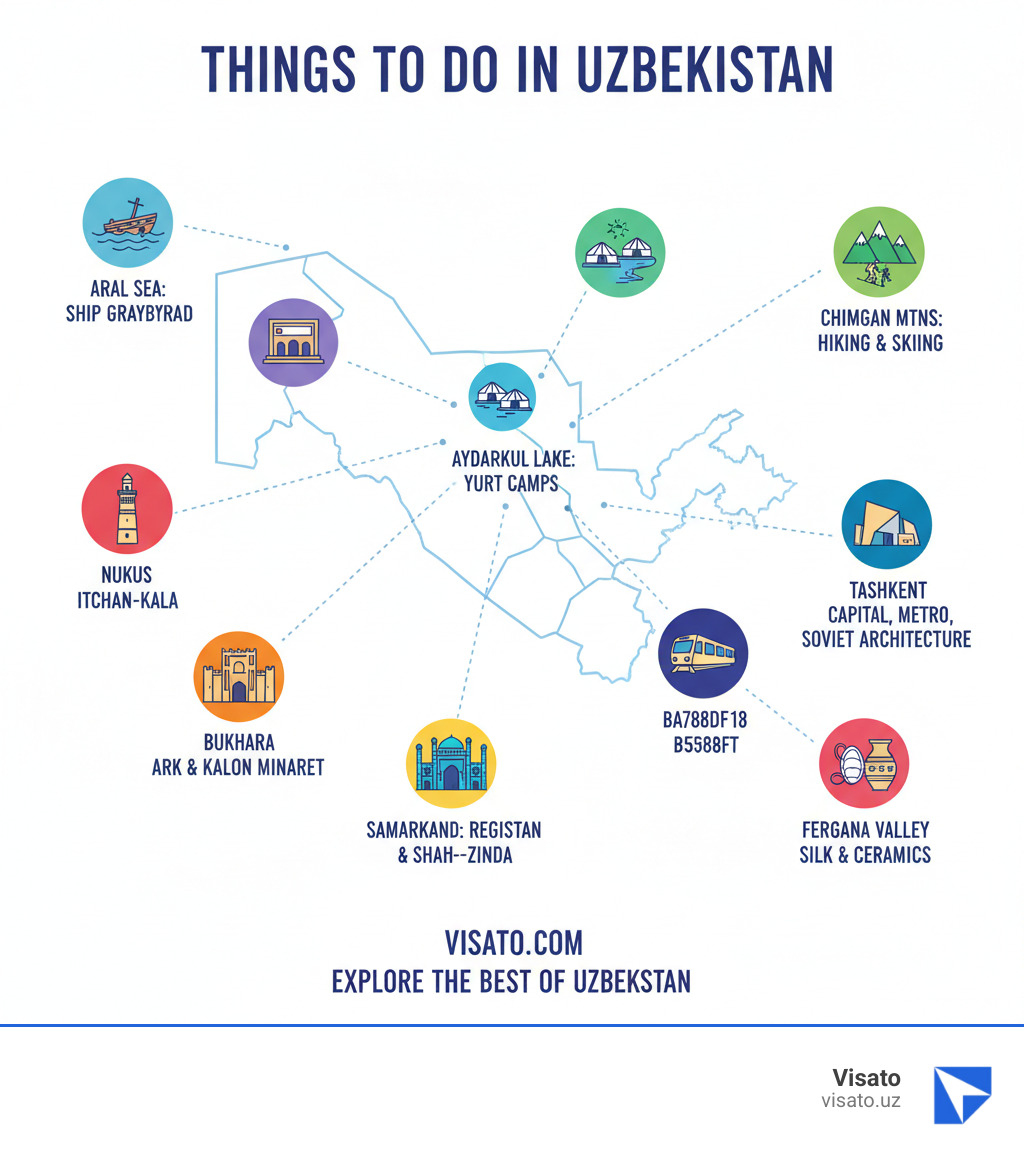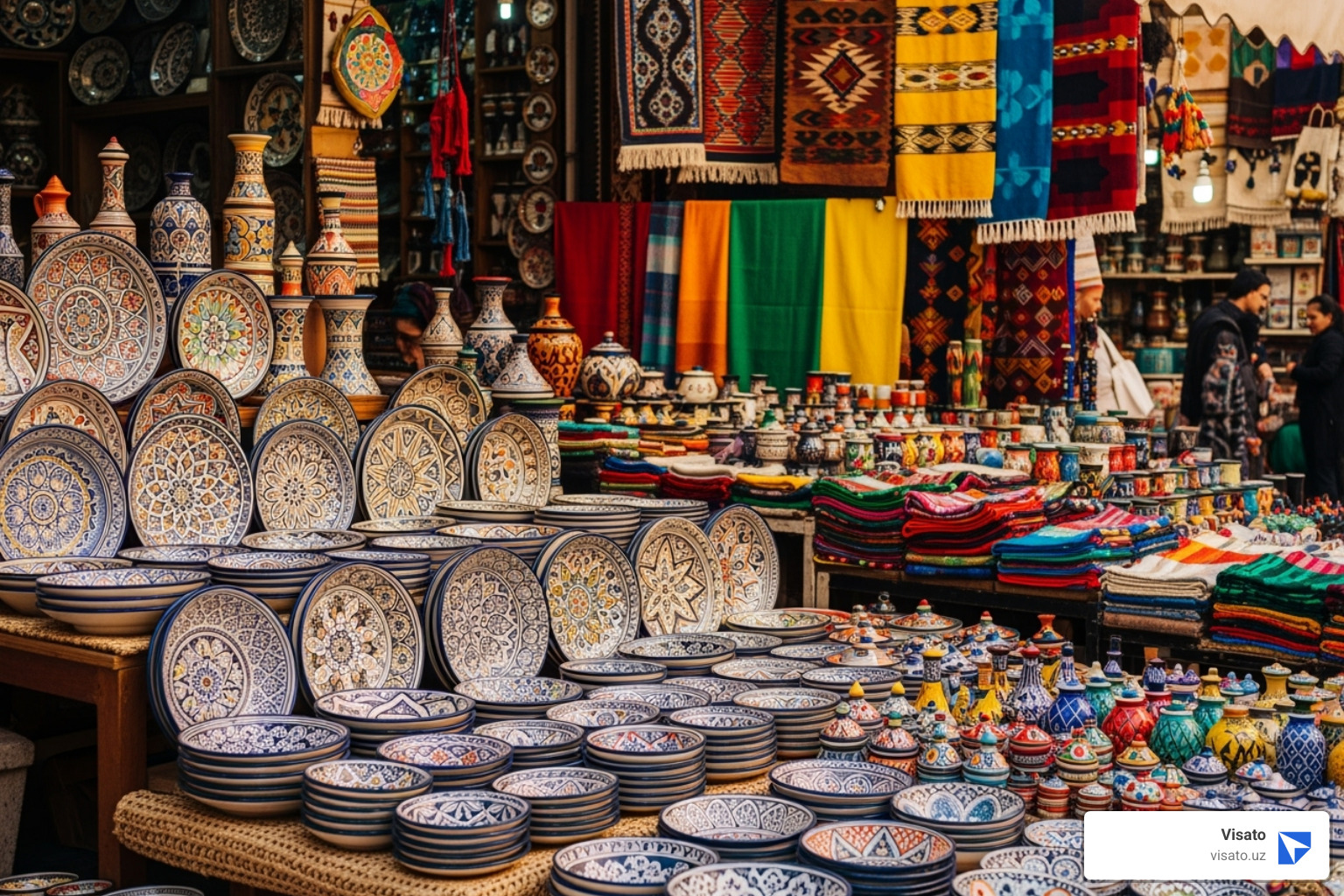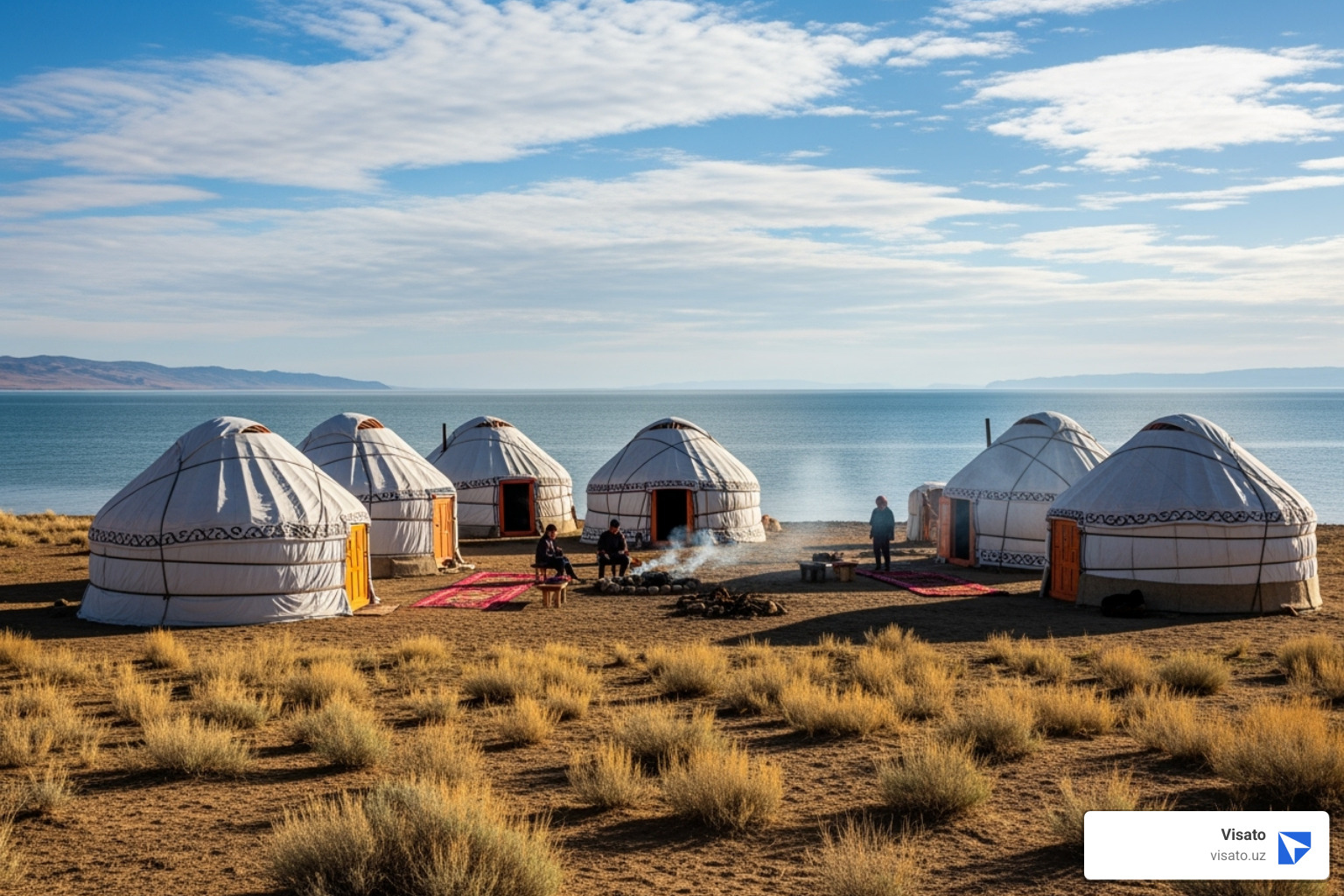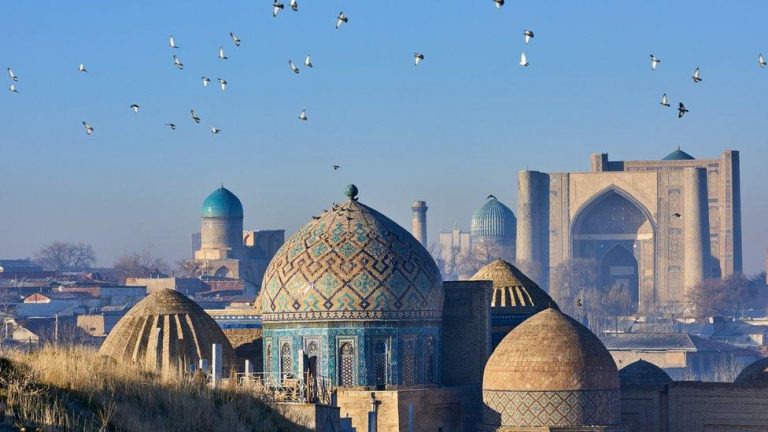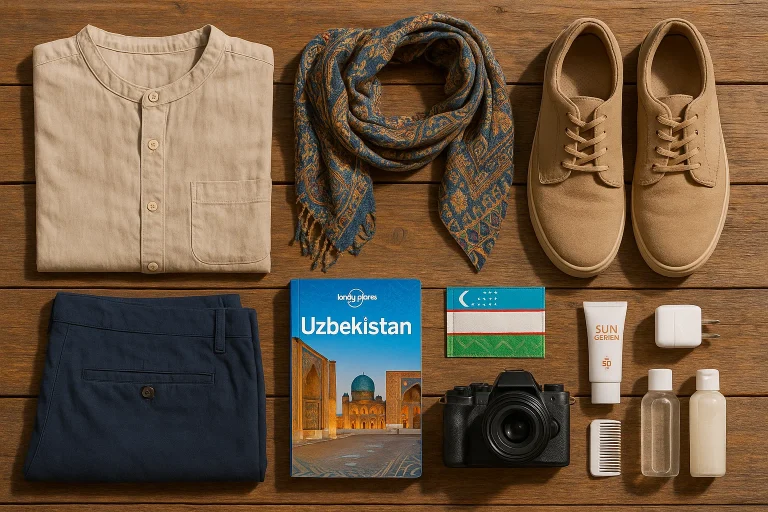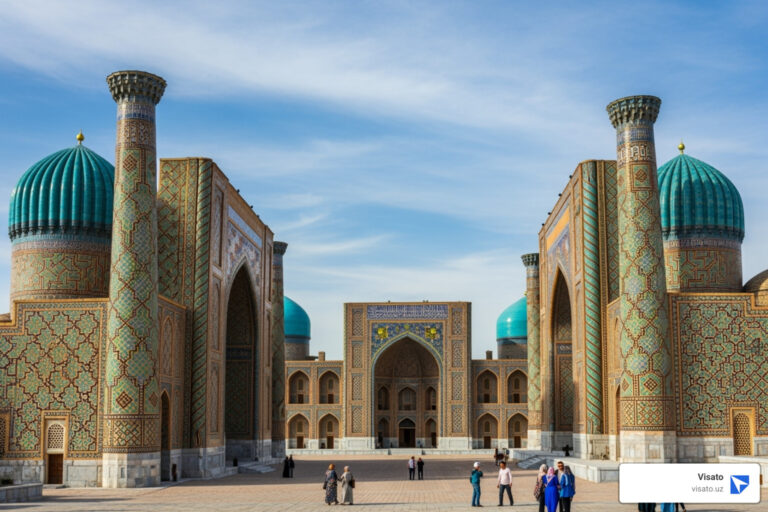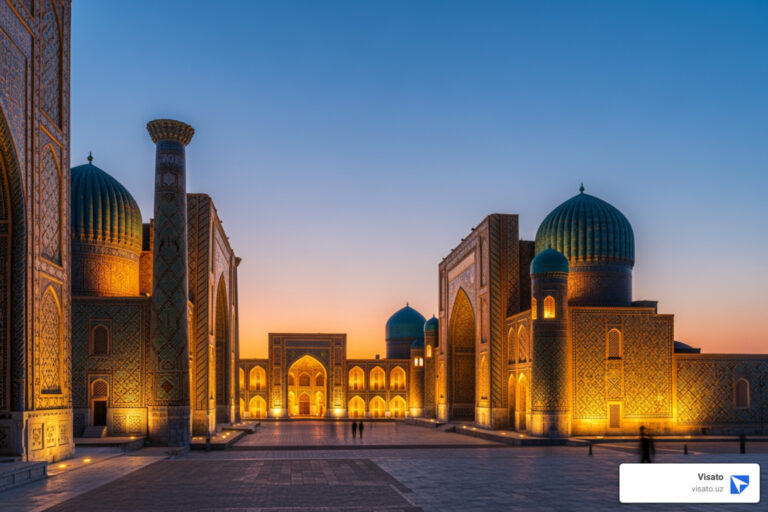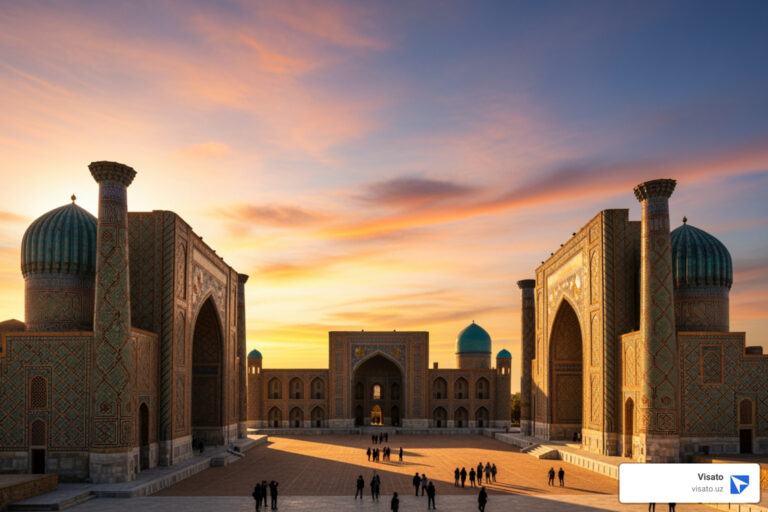Why Uzbekistan Should Be on Every Traveler’s Bucket List
Things to do in Uzbekistan range from exploring ancient Silk Road cities to staying in traditional yurt camps under starlit skies. Here’s what awaits you:
- Architectural Marvels: Visit UNESCO World Heritage sites like Registan Square, Shah-i-Zinda Necropolis, and Itchan-Kala
- Cultural Immersion: Taste authentic plov, learn silk paper making, and shop at vibrant bazaars
- Natural Adventures: Ski in Amirsoy mountains, visit the Aral Sea ship graveyard, or camp near Aydarkul Lake
- Historical Deep Dives: Explore Sufi shrines, Soviet-era metro stations, and hidden avant-garde art collections
- Authentic Experiences: Stay with local families in mountain villages and relax in traditional hammams
Landing in Central Asia for the first time can feel both exciting and overwhelming. Uzbekistan sits at the crossroads of ancient civilizations, where grand Islamic architecture meets Soviet modernism, where busy bazaars overflow with handmade ceramics, and where warm hospitality greets you at every turn.
The country preserves over 2,000 years of history along the legendary Silk Road. Cities like Samarkand, Bukhara, and Khiva showcase some of the world’s most stunning Islamic architecture—think intricate blue-tiled mausoleums, towering minarets, and madrassahs decorated with golden mosaics. But Uzbekistan offers far more than historical monuments.
Beyond the famous landmarks, you’ll find:
- Rugged mountains perfect for hiking and skiing
- Desert landscapes where nomadic traditions live on
- Fertile valleys producing silk and ceramics using centuries-old techniques
- Thriving art scenes in unexpected places like Nukus
- Culinary traditions with over 30 regional variations of the national dish, plov
The best part? Uzbekistan remains wonderfully accessible and affordable. High-speed trains connect major cities in under three hours. E-visas arrive in your inbox within days. English-speaking guides and guesthouses make navigation easy, even in remote areas.
Whether you’re drawn to the grandeur of Timur’s empire, the spiritual depth of Sufi shrines, the adventure of mountain trekking, or simply the chance to experience genuine Central Asian hospitality, Uzbekistan delivers experiences you won’t find anywhere else.
I’m Nariman Huseynov, and through my work at Visato, I’ve helped thousands of travelers find the incredible things to do in Uzbekistan while simplifying their visa applications. Over five years of working with international visitors has shown me that this country consistently exceeds expectations—and I’m excited to share the highlights that will make your journey unforgettable.
Journey Through Time: Uzbekistan’s Architectural Wonders
Standing in front of Uzbekistan’s ancient monuments feels like touching history itself. The turquoise domes, intricate tilework, and towering minarets aren’t just beautiful—they’re storytellers. Each structure whispers tales of Silk Road caravans, brilliant astronomers, fierce conquerors, and devoted artisans who spent lifetimes perfecting a single mosaic pattern.
For centuries, Uzbekistan served as the crossroads of civilizations. Empires rose and fell here. Scholars gathered in its madrassahs to debate mathematics and astronomy. Traders from China, Persia, and Europe exchanged goods and ideas in its busy squares. Today, exploring these architectural treasures ranks among the most rewarding things to do in Uzbekistan.
The best part? These aren’t museum pieces behind velvet ropes. You can walk through the same courtyards where medieval students once studied, touch the same walls that sheltered silk merchants, and climb stairs worn smooth by countless footsteps over centuries.
Essential Things to Do in Uzbekistan’s Silk Road Cities
Samarkand hits you first with its sheer grandeur. Registan Square stands as the undisputed crown jewel—not just of the city, but of all Central Asia. Three madrassahs face each other across an open plaza, their facades covered in mosaics that shift from deep cobalt to turquoise to gold depending on the sunlight.
The 15th-century Ulugh Beg Madrassah takes its name from Timur’s grandson, who was more interested in astronomy than conquest. The Tilla-Kori Madrassah translates to “gold-covered,” and once you step inside its mosque and see the ceiling, you’ll understand why. The Sher-Dor Madrassah breaks Islamic tradition by depicting lions and suns with human faces on its facade—a quirky detail that makes it unforgettable.
Visit around 8 AM before the tour buses arrive, or return at sunset when the tiles seem to glow from within. Your admission ticket typically works all day, so take advantage. Climb to the second floor of one of the madrassahs for a perspective that few visitors bother to find—you’ll have the courtyard practically to yourself up there.
Just northeast of the city center, the Shah-i-Zinda Necropolis offers something different—intimacy instead of grandeur. This avenue of mausoleums climbs a hillside like a stairway to heaven. Built between the 11th and 19th centuries, each tomb showcases different tilework styles and color palettes.
The site takes its name—”Living King”—from its most sacred tomb, believed to hold Qusam ibn-Abbas, a cousin of Prophet Mohammed who brought Islam to Central Asia. Pilgrims still visit to pray and seek blessings. The atmosphere at sunset becomes almost magical, with golden light warming the blue tiles and creating moments of profound peace.
Timur himself rests in the Gur-e-Amir Mausoleum, though he never intended to. He built this magnificent structure for his beloved grandson Muhammad Sultan, but when the great conqueror died suddenly in 1405, his sons laid him to rest here instead. The fluted turquoise dome rises like a ribbed melon, while inside, the decoration reaches levels of refinement that take your breath away. The actual tombs sit in a crypt below the ornate markers you see at ground level.
The Bibi-Khanym Mosque tells a bittersweet story. Timur ordered its construction after returning from conquering India, determined to build the largest mosque in the Islamic world. Legend says his favorite wife Bibi-Khanym supervised the project while he was away, and the architect fell so deeply in love with her that he demanded a kiss before finishing the work. The kiss left a mark on her cheek, and when Timur finded the betrayal, he ordered all women to wear veils.
The mosque’s ambition exceeded medieval engineering capabilities—parts began crumbling even during construction. Today it stands partially ruined but still magnificent, with a massive marble Quran stand in the courtyard. Local women believe that crawling under this stand brings fertility—a bit of folklore that adds charm to the historical grandeur.
In Khiva, Itchan-Kala transports you to a different era entirely. This walled inner city has remained virtually unchanged for a century. Walking through its gates feels like stepping onto a movie set, except everything is real. The Kalta Minor Minaret dominates the skyline with its turquoise tiles—it’s called the “Short Minaret” because the khan who ordered it died before construction finished, leaving it at about one-third of its intended height.
The Kunha Ark Fortress served as the khan’s residence, while the Tosh-Hovli Palace showcases the opulent lifestyle of Khiva’s rulers with its intricate wood carvings and majolica tiles. Every corner of Itchan-Kala offers photo opportunities, but hiring a local guide for a three-hour tour helps you understand the stories behind the stunning facades.
Bukhara’s Ark Fortress has witnessed the longest span of history—it dates back to the 5th century and served as a royal city-within-a-city until 1920. Standing before its massive sloped walls, you can almost hear the echoes of court intrigues, royal proclamations, and the daily bustle of palace life that continued here for 1,500 years.
The Kalon Minaret earned a grim nickname—the “Tower of Death”—because medieval rulers executed criminals by throwing them from its top. Built in 1127, it soared 150 feet high, making it Central Asia’s tallest building for centuries. Genghis Khan reportedly spared it from destruction because he was so impressed when he looked up at it. Today it anchors the Poi Kalyan Complex, flanked by the grand Kalyan Mosque and the still-functioning Mir-i-Arab Madrassah.
After a day of monument-hopping, the Lyabi-Hauz Complex offers respite. This plaza centers on a large pond surrounded by ancient mulberry trees. Madrassahs and a khanaka (Sufi lodge) frame the water, while locals and travelers alike gather on the steps to rest, chat, and sip tea. It’s the perfect spot to let centuries of history settle into your bones while watching everyday life unfold around you.
Explore the Legacy of Sufism and Ancient Beliefs
Beyond the grand monuments and royal palaces, Uzbekistan’s spiritual heritage runs deep. Sufism—Islamic mysticism focused on direct experience of the divine—flourished here for centuries, though it faced suppression during Soviet times and remains somewhat controversial today.
A half-hour drive from Bukhara’s old city brings you to the Naqshbandi Memorial Complex, birthplace of Bahauddin Naqshbandh Bukhari. This 14th-century Sufi saint founded the Naqshbandi order, one of Islam’s most influential mystical traditions. The complex surrounding his tomb has grown into a major pilgrimage site where believers come seeking spiritual guidance and blessings.
Even if you’re not particularly religious, the atmosphere here touches something deeper. The complex feels serene in a way that busy tourist sites don’t. Late afternoon light filters through the courtyard, casting long shadows across the marble. Pilgrims pray quietly while others sit in contemplation. It’s a space that invites reflection regardless of your beliefs.
Understanding this Sufi heritage took time—the history isn’t always prominently displayed or discussed. But finding it adds profound depth to your appreciation of Uzbek culture. You can learn more about this influential figure at Bahauddin Naqshbandh Bukhari.
Back in Tashkent, the Hazrati Imom Complex serves as the capital’s spiritual heart. This collection of mosques, madrassahs, and mausoleums includes the Moyie Mubarek Library Museum, home to the Osman Quran—one of the world’s oldest Quran manuscripts, dating to the 7th century and reportedly stained with the blood of Caliph Uthman ibn Affan.
The complex’s Friday Mosque (Hazrati Imom Jume Masjidi) offers moments of genuine peace. Sitting quietly in its courtyard, away from the city’s traffic and bustle, you can sense the devotion and scholarly tradition that have shaped Uzbekistan across centuries. It’s one of those places that stays with you long after you leave.
Immerse Yourself in Vibrant Uzbek Culture
The soul of Uzbekistan reveals itself not just in ancient monuments, but in the warmth of its people, the aromas wafting from busy market stalls, and the careful hands of artisans preserving centuries-old crafts. For us, connecting with this living, breathing culture ranks among the most memorable things to do in Uzbekistan—experiences that transform a trip into something truly unforgettable.
Taste the Flavors of the Silk Road
The moment you sit down to your first proper Uzbek meal, you’ll understand why food here isn’t just sustenance—it’s storytelling on a plate. Central Asian, Persian, and nomadic traditions blend into hearty dishes that have fueled travelers along the Silk Road for centuries.
Let’s talk about plov. This isn’t simply rice with meat. It’s a national obsession, a point of regional pride, and the centerpiece of celebrations. More than 30 varieties exist across Uzbekistan, each master chef guarding their recipe like family treasure. In Tashkent, we always make time for the Besh Qozon Plov Center, where massive cauldrons bubble away, each one feeding up to 500 people. Watching the steam rise from those giant kazans while the aroma of cumin and sizzling lamb fills the air—that’s pure magic.
But here’s our insider tip: plov is wonderfully filling (perhaps too filling!), so we recommend enjoying it for lunch rather than dinner. Balance the richness with fresh vegetable salads, tangy yogurt, and plenty of green tea. In the Fergana Valley, particularly in Kokand or Rishtan, we seek out traditional chaikhanas (teahouses) where you can eat plov while lounging on wooden platforms beside flowing water—exactly as travelers have done for generations.
Beyond plov, Uzbek cuisine offers endless delights. Samsa—those golden pastries fresh from the clay tandyr oven, stuffed with spiced meat or sweet pumpkin—make perfect street food. Lagman, with its hand-pulled noodles swimming in savory broth, warms you from the inside out. In Khiva, don’t miss shivit oshi, a distinctive green dill pasta that you won’t find anywhere else, or the delicate dumplings called gumma and yumurta barak. Every meal comes with non, the round flatbread that’s baked fresh throughout the day and serves as both plate and utensil.
Here’s something that surprises many visitors: Uzbekistan produces wine! During Soviet times, Uzbek dessert wines won international awards, and the industry has flourished again in recent years. A visit to Uzumfermer family winery, just 30 minutes from Tashkent, reveals this hidden treasure. The name comes from uzum, the Uzbek word for grape, and family members personally guide you through vineyards and production facilities, sharing stories alongside generous tastings. In Samarkand, the historic Hovrenko factory offers another window into this tradition.
No cultural immersion feels complete without diving into the sensory chaos of local bazaars. Chorsu Bazaar in Tashkent, with its distinctive blue dome, buzzes with energy seven days a week. We love getting lost among stalls piled high with crimson spices, golden raisins, emerald herbs, and pyramids of nuts. Siab Bazaar in Samarkand sits conveniently near Bibi-Khanym Mosque, perfect for picking up dried apricots and local honey. Even Bukhara’s smaller Central Bazaar offers treasures if you know where to look. These aren’t tourist attractions—they’re where locals shop, gossip, and negotiate, offering you a front-row seat to daily Uzbek life.
Master Ancient Crafts and Traditions
Walking into artisan workshops across Uzbekistan feels like stepping into living museums, where techniques perfected over centuries continue through skilled hands and patient teaching.
At the Meros Paper Mill in Samarkand, we watched in fascination as craftsmen transform mulberry bark into exquisite silk paper using methods practiced here for over 1,000 years. The entire process is eco-friendly and meditative—soaking, pounding, pressing, and drying each sheet by hand. The paper itself makes a meaningful souvenir, carrying with it centuries of Silk Road history.
The Fergana Valley pulses with creative energy. In Rishton, entire families dedicate themselves to ceramic-making, their kilns glowing late into the evening. We’ve spent afternoons in home studios watching master potters shape clay on spinning wheels, then paint intricate patterns with steady brushstrokes. Many families welcome visitors for hands-on masterclasses—there’s something deeply satisfying about creating your own (slightly wobbly) bowl under expert guidance. The Rishton Ceramic Museum provides context for this vibrant tradition.
Just down the road in Margilan, the Yodgorlik Silk Factory preserves the mesmerizing art of ikat weaving. We stood transfixed watching weavers create those signature flowing patterns, the threads dyed in precise sections before weaving begins. The resulting fabrics shimmer with colors that seem to shift and blend as you move—it’s no wonder Uzbek silk captivated merchants for centuries.
The delicate art of miniature painting demands extraordinary patience and precision. At the School of Miniature Painting in Bukhara, artists work with brushes so fine they contain just a few hairs, creating intricate scenes packed with detail. Some travelers become so enchanted they return for weeks-long courses. We find that visiting local artists in their home studios offers the most intimate creative experience—watching them work while sharing tea and stories.
Suzani embroidery represents another treasured tradition. These vibrant hand-stitched panels, bursting with floral and celestial motifs, once formed essential parts of every bride’s dowry. Today, you’ll find them in bazaars and workshops, each one unique, each pattern telling its own story through color and design.
Connect with Local Life and People
The monuments and museums provide Uzbekistan’s framework, but the people fill it with warmth and meaning. For us, the connections we make with locals create the memories that linger longest.
Choosing a family-run guesthouse over standard hotels changes everything. At Gulnara Guesthouse in Tashkent, our 70-year-old hostess welcomed us like family. Breakfast on the tapchan—traditional lounge seating under persimmon trees—turned into long conversations about life, history, and her grandchildren. That genuine hospitality, the feeling of truly belonging somewhere, can’t be manufactured or purchased.
For an even deeper immersion, we recommend a homestay in the Nuratau Mountains. Through Responsible Travel Uzbekistan, we spent unforgettable days in Uhum village, living with a local family. We hiked in search of 2,000-year-old petroglyphs, picked mulberries straight from the trees, helped prepare meals, and listened to legends passed down through generations. Rural Uzbekistan moves at a different pace, guided by seasons and traditions rather than schedules—experiencing this offers profound insights you’d never gain from cities alone.
After days of walking ancient streets and climbing minaret stairs, sinking into a traditional hammam (bathhouse) feels like pure bliss. Bukhara’s medieval bathhouses, some dating back centuries, offer rejuvenating experiences—steamy rooms, invigorating scrubs, and the kind of deep relaxation that only comes from ancient wellness traditions.
If your travel dates align with local festivals, don’t miss them. Nowruz, celebrating spring’s arrival around March 21st, transforms cities with music, dancing, special foods, and joyous gatherings. The Boysun Bahori folklore festival in May showcases traditional music, dance, and crafts in a spectacular mountain setting. These celebrations reveal Uzbek culture at its most vibrant and communal, welcoming visitors into the circle of celebration.
A Curated List of Unforgettable Things to Do in Uzbekistan
The Silk Road cities are magnificent, but they’re just the beginning. Uzbekistan’s surprises extend far beyond ancient madrassahs and blue-tiled domes. We’ve finded snow-capped mountains perfect for skiing, haunting desert landscapes, underground art galleries, and opportunities to sleep under stars so bright they seem unreal. These lesser-known adventures are what transform a good trip into an extraordinary one, offering some of the most memorable things to do in Uzbekistan.
Find Uzbekistan’s Diverse Natural Landscapes
Most travelers picture Uzbekistan as a land of ancient cities and desert caravans. While that’s true, the country’s natural landscapes are surprisingly varied—from alpine peaks to serene lakes and even one of the world’s most sobering environmental disasters.
The Aral Sea ship graveyard near Muynak stands as a stark reminder of human impact on nature. What was once the world’s fourth-largest lake has shrunk dramatically due to Soviet-era irrigation projects. We find ourselves standing in what used to be a thriving fishing port, now surrounded by nothing but sandy desert. Rusting ships sit abandoned in the sand, miles from any water—a surreal and haunting sight that photographs can’t quite capture. Getting here requires commitment; it’s typically a two-day journey from Nukus by 4WD, but the powerful impressions and unique perspective on environmental change make it worthwhile.
For winter sports enthusiasts, the Amirsoy mountain resort has put Uzbekistan on the skiing map since opening in 2019. Nestled in the Chimgan Mountains, this modern facility offers excellent conditions for skiing and snowboarding with infrastructure that rivals many European resorts. We love that Uzbekistan now offers world-class winter sports alongside its historical treasures.
The Chimgan Mountains themselves are a revelation, especially during spring and autumn. These peaks, part of the Tian Shan range, offer pristine hiking trails with panoramic views that stretch for miles. Fresh mountain air, alpine meadows, and the chance to explore on foot provide a refreshing contrast to city sightseeing. For the truly adventurous, heli-skiing opportunities exist in these remote regions.
One of our favorite escapes is Aydarkul Lake, where we can experience nomadic traditions firsthand. This vast lake in the Kyzylkum Desert is surrounded by yurt camps that offer an authentic taste of Central Asian nomadic life. We’ve spent evenings here riding camels across the dunes, watching traditional folklore performances, and gazing up at skies so clear that the Milky Way stretches from horizon to horizon. The yurts themselves are surprisingly comfortable, with proper mattresses and separate washroom facilities. There’s something magical about sunrise over the desert when you’re staying in a traditional felt dwelling—it’s a connection to centuries of nomadic heritage that no hotel can replicate.
Speaking of celestial wonders, Uzbekistan’s clear desert and mountain skies create perfect conditions for stargazing. The Maidanak observatory in the mountains is a testament to the country’s astronomical heritage, and on any clear night away from the cities, the cosmos reveals itself in breathtaking detail.
Uncover Soviet History and Modern Art
Uzbekistan’s Soviet period left fascinating architectural and cultural legacies that offer a completely different lens through which to view the country. These remnants of the 20th century coexist with ancient monuments, creating a unique historical mix.
The Tashkent Metro stations are our favorite unexpected attraction in the capital. Built after the devastating 1966 earthquake and designed to double as nuclear bunkers, each station is a work of art. We ride the metro not just for transport but to explore underground galleries decorated with ornate chandeliers, marble, granite, and intricate mosaics. The Alisher Navoiy station celebrates classical Uzbek poetry, while Kosmonavtlar accepts a space-age theme. At around 1200 som per ticket, it’s the cheapest art gallery you’ll ever visit.
Above ground, Tashkent’s Soviet-era modernist architecture tells another chapter of the city’s story. The Hotel Uzbekistan, with its distinctive Brutalist concrete lattice facade, stands as a monument to this period. We enjoy wandering through these structures, appreciating how they represent a completely different aesthetic philosophy from the Islamic architecture that dominates other cities.
In the remote city of Nukus, the Savitsky Museum holds one of the world’s most remarkable collections of Russian avant-garde art. This treasure trove was hidden during Soviet times by its founder, Igor Savitsky, who risked everything to protect these works from destruction. Standing before these rescued paintings, we feel the weight of artistic resistance and cultural preservation. It’s an unexpected masterpiece in an unexpected place—exactly the kind of findy that makes Uzbekistan so fascinating.
Uzbekistan’s contemporary art scene is flourishing, particularly in Tashkent. Young artists are creating bold new works, and galleries like Art Vernissage gallery showcase cutting-edge pieces that reflect modern Uzbek identity. As an emerging art market, it’s even attracting attention from international auction houses. We find visiting these spaces offers insight into where Uzbekistan is heading, not just where it’s been.
More Unique Things to Do in Uzbekistan for the Curious Traveler
For those willing to venture off the standard tourist circuit, several lesser-known destinations reveal different facets of Uzbekistan’s rich cultural mosaic.
Shakhrisabz, Amir Timur’s birthplace, makes an excellent day trip from Samarkand. The ruined Ak-Saray Palace dominates the town—even in its current state, the massive portal and fragments of walls hint at the structure’s former magnificence. Inscriptions at the entrance once proclaimed that anyone doubting Timur’s power should look upon his buildings and tremble. The Dorut Tilovat Complex and other monuments round out this UNESCO World Heritage site.
The Fergana Valley often gets skipped by first-time visitors, but it shouldn’t be. This fertile region is Uzbekistan’s heartland for traditional crafts and agriculture. In Kokand, the grand palace of Khudayar Khan impresss with its colorful tilework and intricate 19th-century Central Asian architecture. The valley is also where you’ll find the finest Rishton ceramics and Margilan silk, produced using techniques passed down through generations. We find that spending time here offers a more intimate understanding of traditional Uzbek life.
Bukhara’s Jewish history surprised us when we first stumbled upon a 16th-century synagogue tucked away in the old city. The Jewish community here dates back over a millennium, and their influence enriched Bukhara’s cultural fabric. We were particularly delighted to find the 133-year-old house of a Jewish merchant, now beautifully refurbished as the Lyabi House Hotel and home to Ayvan restaurant. Dining in the summer room of this historically significant building, surrounded by original architectural details, offers a special connection to Bukhara’s multicultural past.
Even in busy Tashkent, pockets of old-world charm survive. Following an old Tashkent walking trail through the city’s traditional mohallas (neighborhoods) reveals a completely different character from the broad Soviet avenues. We wander through narrow, tree-lined streets past traditional clay houses with carved wooden doors, finding a village-like atmosphere hidden within the modern capital. It’s these quiet neighborhoods where we often have the most meaningful conversations with locals, sipping tea in courtyards and hearing stories that guidebooks never tell.
Frequently Asked Questions about Visiting Uzbekistan
After helping thousands of travelers plan their journeys through Visato, I’ve noticed the same questions come up again and again. Let me share straightforward answers to help you plan your adventure with confidence.
How many days are enough for Uzbekistan?
This is probably the question I hear most often, and honestly, it depends on what you want to experience. For a classic Silk Road journey hitting the highlights of Tashkent, Samarkand, and Bukhara, 7 to 10 days gives you enough time to really appreciate each city without constantly rushing from one monument to the next.
During this time, you’ll have space to wander through Registan Square at different times of day, linger over tea in a chaikhana, explore the bazaars, and maybe even take a half-day trip to places like the Naqshbandi Complex or Shakhrisabz.
Planning to venture further afield? If Khiva’s walled city and the haunting Aral Sea ship graveyard are calling your name, add another 3 to 4 days to your itinerary. The journey to these remote areas takes time, but the experiences are absolutely worth it. I’ve seen travelers try to squeeze everything into five days, and they always tell me they wished they’d allowed more time to simply absorb the atmosphere and connect with local people.
Is Uzbekistan safe for tourists?
I can answer this one with genuine enthusiasm: yes, Uzbekistan is remarkably safe for tourists. This includes solo female travelers, which I’m always happy to reassure people about. The country consistently ranks as one of the safest destinations in Central Asia.
Uzbek hospitality isn’t just a tourism slogan—it’s deeply embedded in the culture. Locals genuinely enjoy welcoming visitors and sharing their heritage. During my years working with international travelers, I’ve heard countless stories of strangers inviting tourists for tea or helping them find their way without expecting anything in return.
That said, common sense still applies. Keep an eye on your belongings in crowded bazaars like Chorsu or Siab. Dress modestly when visiting mosques and religious sites—think covered shoulders and knees. And like anywhere, avoid displaying expensive jewelry or large amounts of cash.
The biggest “risk” you’ll face? Probably eating too much plov because your host insists you have a third helping!
What is the best time to visit Uzbekistan?
Timing your visit makes a huge difference to your experience. Spring (April to May) and autumn (September to October) are absolutely the sweet spots for exploring things to do in Uzbekistan. During these months, temperatures hover in the comfortable 20-25°C (68-77°F) range—perfect for walking through ancient cities and climbing minarets without melting.
Spring brings blooming apricot and almond trees, while autumn offers golden light that makes those blue-tiled domes even more photogenic. These seasons also coincide with harvest time, meaning the freshest produce at the bazaars and the most flavorful dishes.
Summer (June through August) is a different story. Temperatures regularly soar above 40°C (104°F), especially in cities like Bukhara and Khiva. If you’re visiting during these scorching months, plan your sightseeing for early morning and late afternoon, and accept the local habit of a long, leisurely lunch indoors during peak heat.
Winter (November to March) sees far fewer tourists and offers its own charm—snow-dusted domes, cozy teahouses, and excellent conditions for skiing at Amirsoy or Chimgan. Just pack warm layers, as temperatures can drop below freezing, particularly in Tashkent and the mountain regions.
No matter when you visit, don’t forget to sort out your e-visa ahead of time. Through Visato’s streamlined e-visa service, you can have your visa approved in just 2-3 business days, leaving you free to focus on planning all the incredible experiences waiting for you in Uzbekistan.
Plan Your Uzbek Adventure
Ready to start on your unforgettable journey? Planning is key to maximizing your experience of all the incredible things to do in Uzbekistan. We’ve compiled essential tips to help you organize your trip seamlessly.
| Season | Best Time to Visit | Recommended Activities |
|---|---|---|
| Spring | April – May | Ideal for city sightseeing, hiking in mountains (Chimgan, Nuratau), enjoying festivals like Nowruz. Pleasant temperatures. |
| Summer | June – August | Very hot. Best for mountain resorts (Amirsoy), lakes (Aydarkul), or indoor activities. Hydration is crucial. |
| Autumn | September – October | Excellent for city tours, cultural experiences, harvest festivals, and comfortable weather for exploration. |
| Winter | November – March | Cold, but perfect for skiing/snowboarding at Amirsoy, exploring snowy landscapes, and fewer crowds in cities. |
Transportation Tips: Getting around Uzbekistan is surprisingly efficient.
- High-Speed Afrosiyob Trains: These modern trains connect major cities like Tashkent, Samarkand, and Bukhara in under three hours, offering a comfortable and scenic way to travel. We always recommend booking tickets well in advance, especially during peak season, as they are in high demand. You can book via the Uzbekistan Railways website.
- Sleeper Trains: For longer journeys, such as to Khiva or Nukus, Soviet-era sleeper cars offer a more atmospheric and often economical travel experience.
- Shared Taxis: For shorter distances or between cities not served by high-speed trains, shared taxis are a common and affordable option.
- Tashkent Metro: As mentioned, the Tashkent Metro is an attraction in itself and an efficient way to steer the capital.
Accommodation Options: Uzbekistan offers a range of unique accommodation styles to suit every traveler.
- Traditional Guesthouses: Especially popular in Bukhara and Khiva, these guesthouses offer a charming stay in beautifully restored traditional houses, often with welcoming family hosts.
- Boutique Hotels: Many historical buildings in the old cities have been converted into stylish boutique hotels, blending modern comfort with traditional aesthetics.
- Yurt Stays: For an unforgettable experience, we highly recommend spending a night or two in a traditional yurt camp in desert regions like near Aydarkul Lake or the Nuratau Mountains. It’s a fantastic way to connect with nomadic culture and enjoy stargazing.
Visa Requirements: Traveling to Uzbekistan has become significantly easier in recent years. Many nationalities can now enter visa-free or obtain an electronic visa (e-visa).
- E-visa Service: For countries that require a visa, the e-visa system is fast, simple, and secure. We at Visato.uz specialize in processing Uzbekistan e-visas, delivering them in as little as 2-3 business days with 24/7 support. This streamlined process removes much of the former complexity, making your travel planning much smoother.
Get your Uzbekistan e-visa for tourism
Final Travel Checklist:
- Currency: The local currency is the Uzbekistani Som (UZS). While US dollars are widely accepted for exchange, credit card machines are rare outside of major hotels and high-end establishments. We always carry sufficient cash for daily expenses and smaller purchases.
- Language: Uzbek is the main language, with Russian also widely spoken. In tourist areas, many people in hospitality speak English, but having a translation app on your phone can be very helpful.
- Connectivity: Local SIM cards are affordable and provide good data coverage in most populated areas.
- Dress Code: While Tashkent is quite modern, we advise dressing conservatively, especially in religious sites and more traditional cities like Bukhara and Khiva. Shoulders and knees should be covered.
- Health: No specific vaccinations are required, but it’s always wise to consult your doctor. Carry basic medications, and be mindful of tap water quality.
With this comprehensive guide, we hope you feel inspired and well-prepared for your adventure. Uzbekistan is a country that truly captures the imagination, offering a blend of ancient wonders, vibrant culture, and genuine hospitality that will leave you with memories to cherish for a lifetime.

